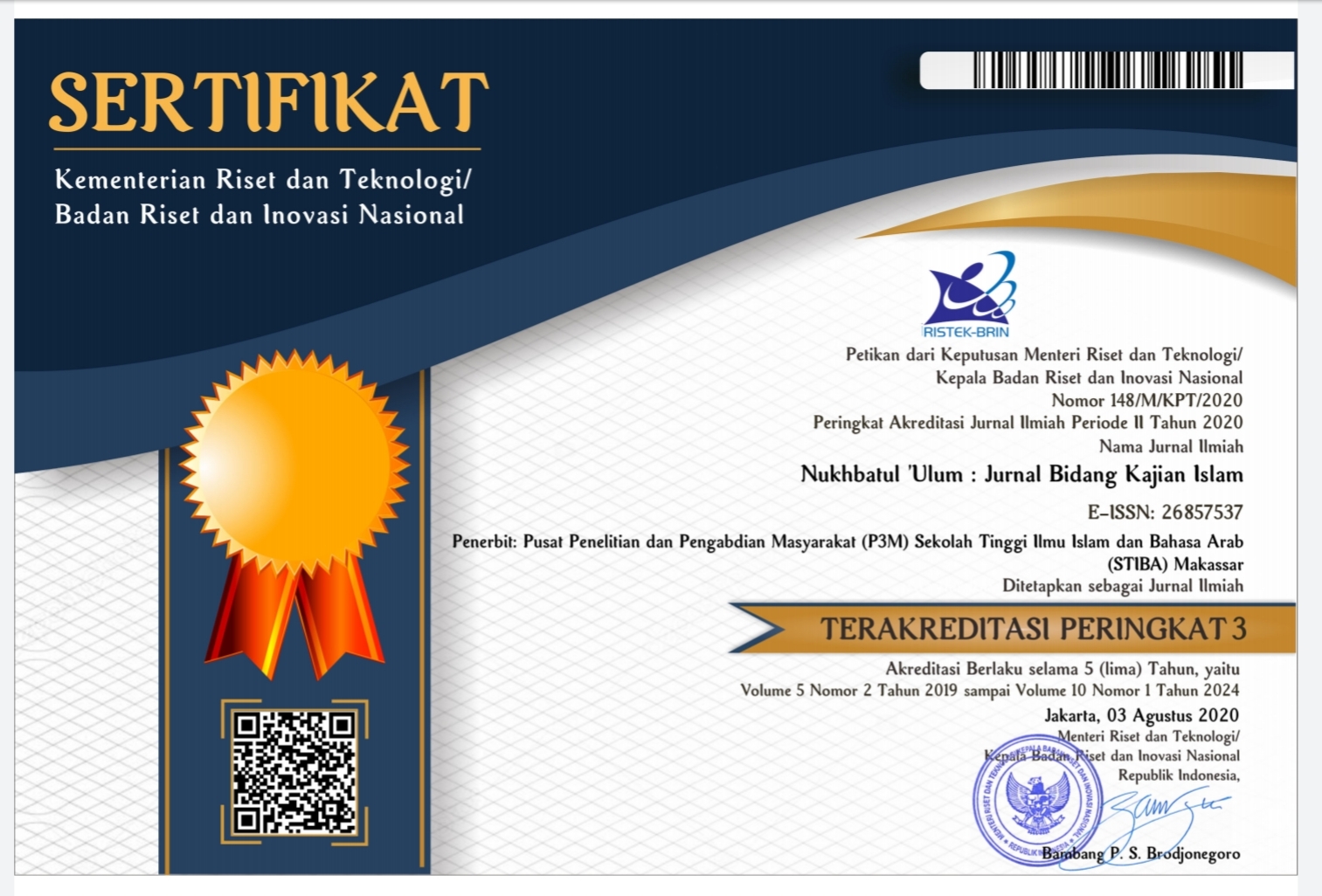Komunikasi Dakwah Rasulullah: Telaah Surat-surat Rasulullah
Da’wah Communication of the Prophet: Prophet ‘s Letters Review
DOI:
https://doi.org/10.36701/nukhbah.v5i1.50Keywords:
letter, communication, prophet, da’wah, kingAbstract
This study aimed to describe the background of letter’s used as a medium for da'wah by the Prophet Muhammad and the form of the Prophet Muhammad’s letters for da'wah conveyed to some rulers. To achieve this, the method employed was historical research. This type of research was qualitative using historical approach while the research specification was descriptive. The result shows that there were several reasons behind the sending of letters as a medium for da’wah by Prophet Muhammad to the rulers. First, sociologically it was due to the treaty of Hudaibiyah, then the successfulness of Prophet Muhammad in establishing people power in Medina, and the conflict between Emperor Heraclius and Khosrow Abrawiz, two rulers of two empires (those were Eastern Rome and Persian) which were the most powerful kingdoms in the earth. Second, politically, the letter of Prophet Muhammad had political nuance, that was to declare himself being the ruler of Medina. Third, theologically, it was the universality of Muhammad’s prophetic mission as the leader of the mankind, and the crisis of faith experienced by Negus (Ruler of Abyssinia) and Muqawqis (Ruler of Egypt). To sum up, the form of Prophet’ letters sent to the rulers were awesome, it is proven that the letters of the Prophet which were written by his secretary Zaid son of Thabit were always preceded with Basmalah, while the letters were addressed to disbelieving people. This study has implication on research or study on the importance of letter as a medium for da’wah of the Prophet which can possibly be a method of initiating and or developing da’wah in the present time.
Downloads
References
Al-Ja’fiyyi, Al-Imam Abi ‘Abdillah Muhammad Ibnu Ismail Ibnu Ibrahim Ibnu Mughirah Ibnu Bardazabah Al-Bukhari. (1992), Shahih Bukhari, Juz 1. Beirut- Libanon: Darrul kutub Ilmiyah.
, (1992), Shahih Bukhari, Juz 5. Beirut-Libanon: Darrul kutub Ilmiyah.
Al-Mubarakfury, Syaikh Shafiyurrahman, (2007). Shirah Nabawiyah, Penerjemah: Kathur Suhadi. Jakarta: Pustaka Al-Kautsar.
Al-Uqaili, Syaikh Uhaimid Muhammad, (2001). Surat-Surat Nabi kepada Para Raja dan Panglima Perang, Penerjemah: Wafi Marzuqi Ammar. Surabaya: Putaka Yassir.
Amstrong, Karen. (2001). Muhammad Sang Nabi, Sebuah Biografi Kritis, Penerjemah: Sirikit Syah. Surabaya: Risalah Gusti.
An-Nadwi, Abul Hasan Ali Al-Hasan. (2011). Shirah Nabawiyah, Sejarah Lengkap Nabi Muhammad Shallallahu’alaihi Wasallam, Cet Ke-6. Penerjemah: M. Halabi Hamdi dkk. Yogyakarta: Darul Manar.
Anas, Ahmad. (2006). Paradigma Dakwah Kontemporer. Semarang: PT Pustaka Rizki Putra.
, Irsyaad Asy-Syaari Syarah Shahih Al-Bukhariy, Juz 6. (1993). Beirut-Libanon: Darrul kutub Ilmiyah.
Hart, Michael H. (1986). Seratus Tokoh yang Paling Berpengaruh dalam Sejarah. Penerjemah: Mahbub Djunaidi. Jakarta : Pustaka Jaya.
Haikal, Ahmad Muhammad Husain. (2001). Sejarah Hidup Muhammad, Cet. Ke-25. Penerjemah: Muhammad Husain Haikal,Jakarta:Pustaka Litera AntarNusa.
Hatta, Ahmad, dkk. (2011). The Great Story of Muhammad shallallahu’alaihi wasallam.. Jakarta: Maghfirah Pustaka.
Hisyam, Abdul Malik Ibnu. (1971). Shirah Nabawiyah, Beirut: Darrul Kutub Al-Ilmiah.
Ilaihi, Wahyu, Harjani Hefni. (2007). Pengantar Sejarah Dakwah, Jakarta: Kencana.
Ath-Tabari, Abi Ja’far Muhammad Bin Jarir. (1991). Taarikh Ath-Tabariy, Juz 3, Beirut- Lebanon: Darrul Kutub Ilmiyah.
Azami, Muhammad Mustafa. (2008). 65 Sekretaris Nabi shallallahu’alaihi wasallam, Jakarta: Gema Insani.
Aziz, Moh. Ali. (2004). Ilmu Dakwah, Jakarta: Kencana.
Bachtiar, Wardi. (1996). Metode Penelitian Dakwah. Jakarta: Logos.
.
Basir, Abdul. (2006). Strategi Rekonsiliasi Umat (Studi Analisa atas Kebijakan Nabi Muhammad shallallahu’alaihi wasallam dalam Menyatukan Masyarakat Madinah), (Skripsi, Fakultas Ushuludin IAIN Walisongo Semarang 2006): p. 24-27.
Cangara, Hafied. (2009). Pengantar Ilmu Komunikasi, Edisi Revisi. Jakarta: PT. Raja Grafindo Persada.
Haikal, Ahmad Muhammad Husain. (2001). Sejarah Hidup Muhammad, Cet. Ke-25, Penerjemah:Muhammad Husain Haikal, Jakarta:Pustaka Litera AntarNusa.
Hatta, Ahmad, dkk.. (2011). The Great Story of Muhammad shallallahu’alaihi wasallam., Jakarta: Maghfirah Pustaka.
Hisyam, Abdul Malik Ibnu. (1971). Shirah Nabawiyah. Beirut: Darrul Kutub Al-Ilmiah.
Ilaihi, Wahyu, Harjani Hefni. (2007). Pengantar Sejarah Dakwah. Jakarta: Kencana.
Ilaihi, Wahyu. (2010). Komunikasi Dakwah. Bandung: PT. Remaja Rosda Karya.


















